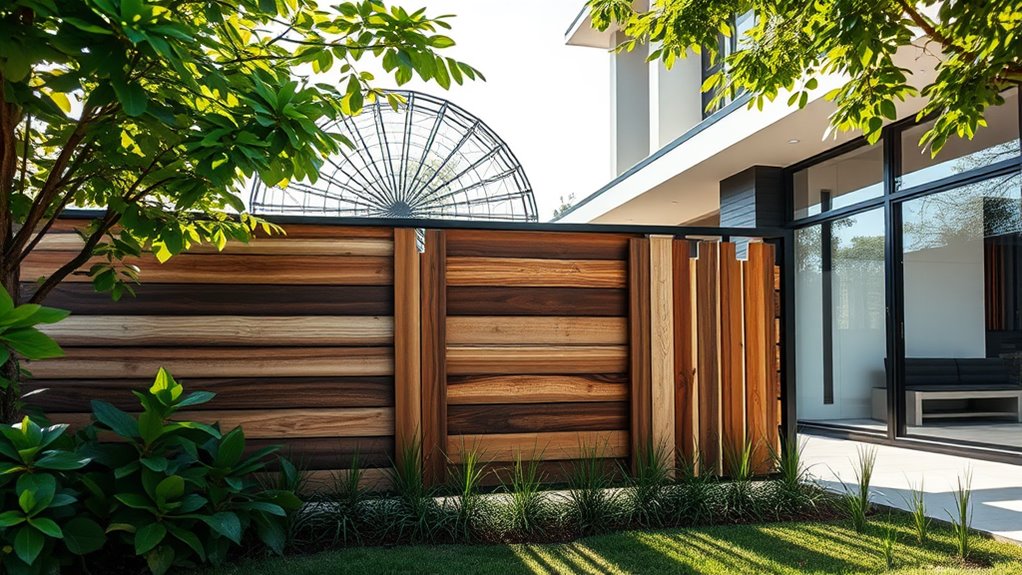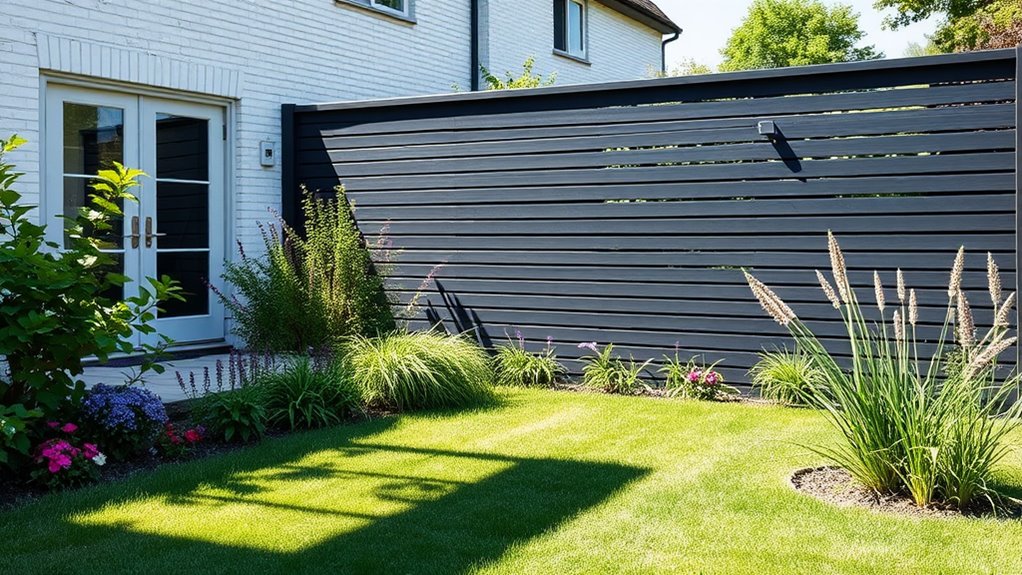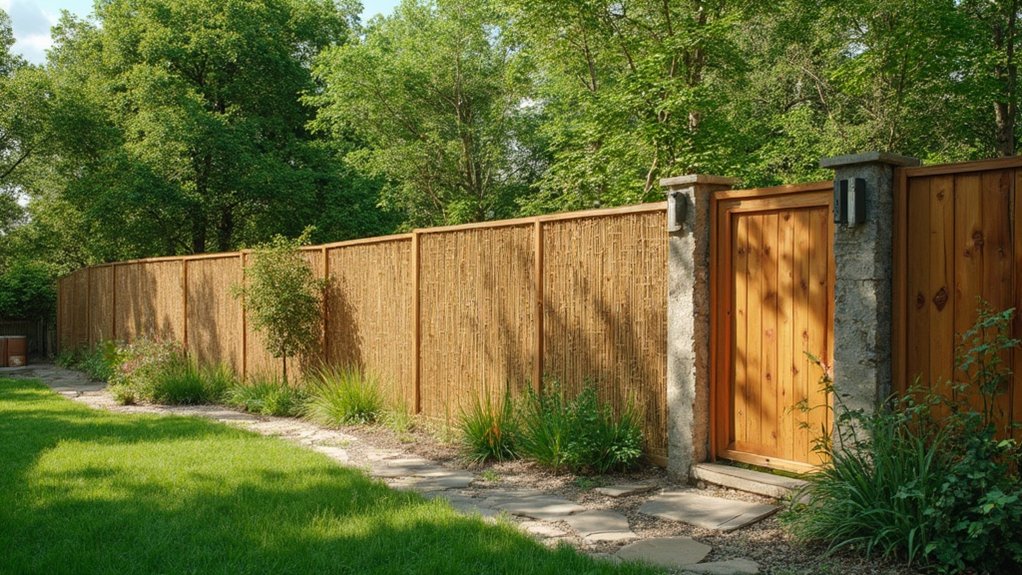To maintain a sustainable fence with minimal impact, start by selecting eco-friendly materials such as bamboo or composite wood. Choose wood that is sustainably sourced to promote responsible forestry practices. Reduce chemical use by opting for natural sealants and eco-friendly cleaners. Consider low-maintenance materials like metal or vinyl for added durability. Incorporate plants or natural elements that support local wildlife. By following these mindful practices, your fence can thrive sustainably while you discover even more effective strategies.
Key Takeaways
- Use natural sealants like linseed or tung oil to protect your wooden fence without harmful chemicals.
- Schedule regular inspections to catch damage early and extend the life of your fence.
- Opt for eco-friendly cleaning products to lessen your environmental footprint during maintenance.
- Keep the area around your fence tidy to prevent wear and tear and support local wildlife.
- Make prompt repairs to avoid bigger problems and ensure your fencing remains sustainable.
Choosing Eco-Friendly Materials for Your Fence
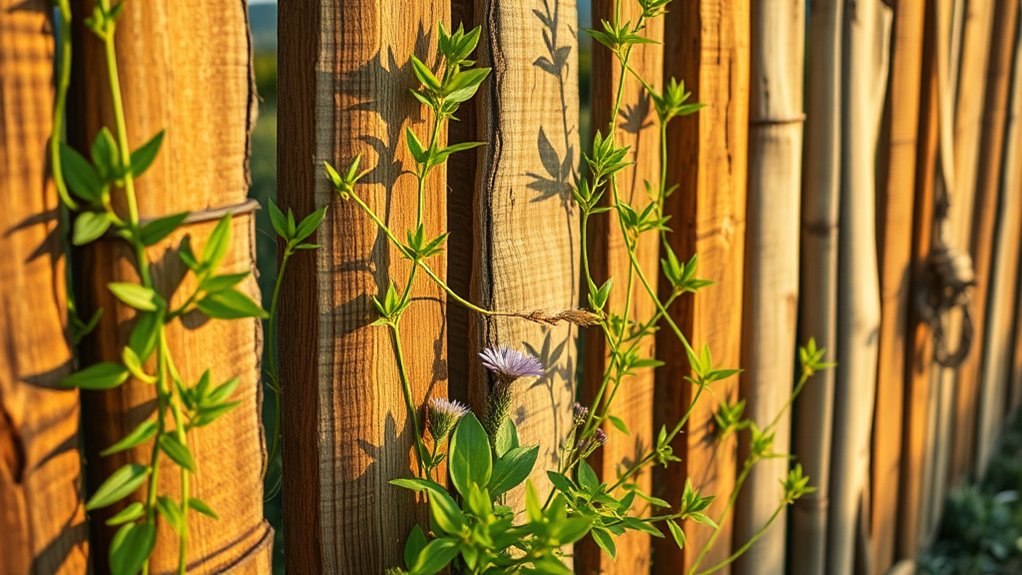
When choosing a fence for your property, consider eco-friendly materials that benefit the environment. Bamboo fencing is a great option; it grows quickly—up to three feet a day—and is twice as strong as cedar. It also resists pests and rot, so no toxic treatments are needed. Additionally, Cali Bamboo Natural Bamboo Fencing promotes eco-friendliness and reduces deforestation. Another option is composite fencing made from recycled plastic and wood fibers. It looks like natural wood but requires less maintenance. Both choices help reduce landfill waste and lower carbon footprints. By selecting these materials, you support sustainability and get a durable, attractive fence. Furthermore, using recycled materials in your fencing contributes to waste reduction and promotes environmentally friendly practices.
Sustainable Wood Sourcing Practices
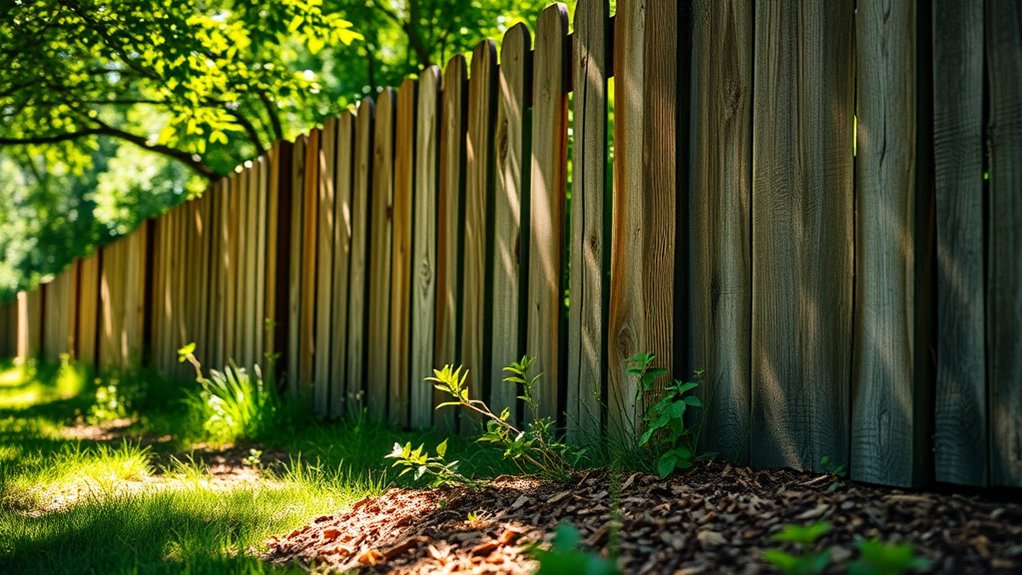
Here are some key practices to consider:
- Choose certified wood: Look for labels like FSC, which ensure the wood is harvested sustainably.
- Support managed forests: Buy from regions that focus on reforestation and responsible forestry practices.
- Opt for reclaimed wood: Using repurposed materials helps reduce waste and lessens the need for new lumber. Additionally, PVC fences are a durable alternative that can last over 50 years without the environmental impact of deforestation.
- Prioritize local sourcing: This minimizes transportation impacts and supports local economies. Additionally, sourcing wood from certified sustainable wood species guarantees that the materials used contribute to responsible forest management practices.
Minimizing Chemical Use in Fence Maintenance
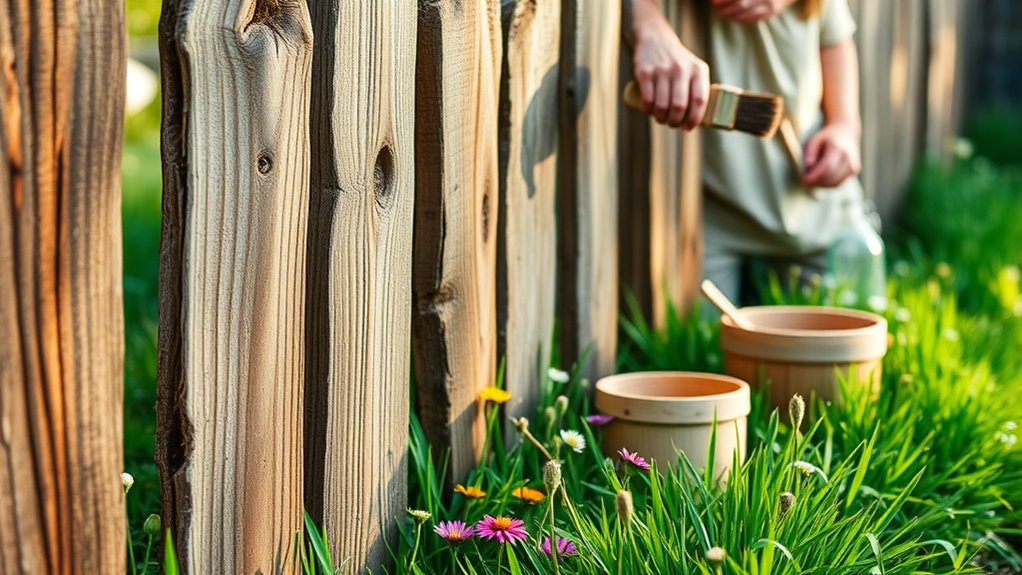
To maintain your fence, use natural sealants like linseed or tung oil to protect the wood without harmful chemicals. Choose pesticide-free options that support eco-friendly practices. These choices not only extend your fence’s life but also promote a healthier environment. Additionally, using natural ingredients in your maintenance routine helps reduce air pollution and supports the sustainability of local ecosystems.
Natural Sealant Alternatives
Keep your fence protected without harsh chemicals by using natural sealant alternatives. Here are some effective options:
- Linseed Oil: Durable and weather-resistant.
- Tung Oil: Moisture-resistant with long-lasting effects.
- Walnut Oil: A natural finish for added protection.
- Rubio Monocoat: A robust finish that combines linseed oil.
These sealants not only prolong the life of your wood but also minimize chemical exposure. Additionally, incorporating weatherproofing treatments can enhance the effectiveness of these natural sealants.
For best results, prepare the surface well and use brushes or sprayers for application.
Regular maintenance will help keep your fence in top shape while you enjoy the benefits of these natural products.
Pesticide-Free Fencing Options
Choosing pesticide-free fencing is a great way to create a sustainable outdoor space while reducing chemical exposure. Consider materials like bamboo, which is strong and quickly renewable. Recycled options like plastic and salvaged wood not only cut down on waste but also ensure durability.
| Fencing Material | Benefits | Maintenance Needs |
|---|---|---|
| Bamboo Fencing | Sustainable, renewable | Minimal maintenance |
| Recycled Plastic Fencing | Eco-friendly, waste-reducing | Low maintenance |
| Salvaged Wood Fencing | Reuses materials | Periodic inspections |
| Composite Fencing | Durable, no chemicals | Very low maintenance |
Enhancing Durability With Low-Maintenance Options
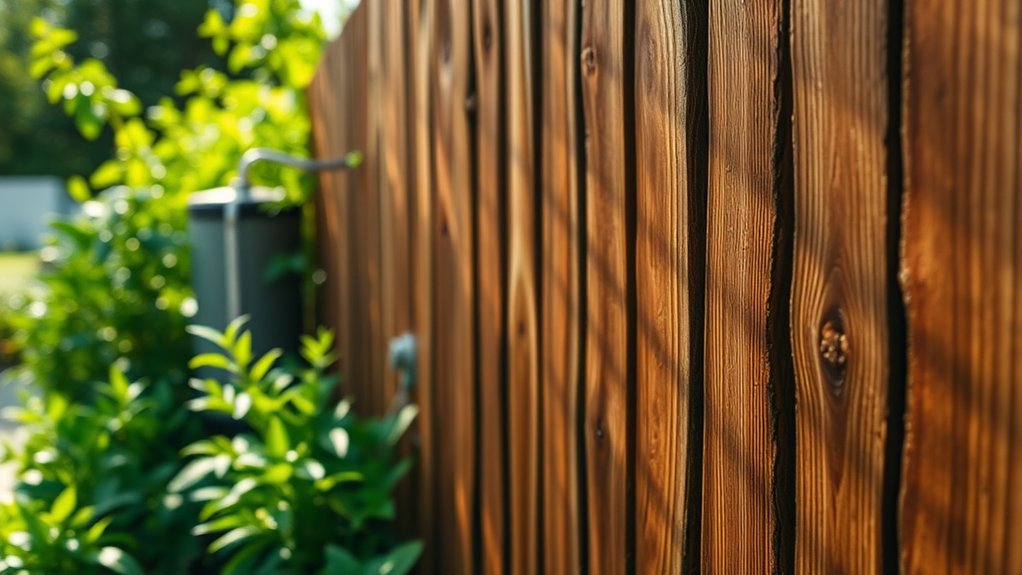
To enhance your fence’s durability, choose weather-resistant materials.
For example, recycled plastic is a strong and eco-friendly option that lasts long and reduces waste.
Weather-Resistant Materials
When selecting materials for your fence, consider weather-resistant options that boost durability and reduce maintenance.
Here are some top choices:
- Composite Fencing: This material resists rot and insects, making it low-maintenance.
- Bamboo Fencing: Strong and naturally pest-resistant, bamboo can endure high winds.
- Metal Fencing: Very durable and weather-resistant, metal fences need little upkeep and can be recycled later.
- Vinyl Fencing: Long-lasting and weather-resistant, vinyl is made from recycled materials, though it may not be as eco-friendly as some alternatives.
Choosing any of these materials can help ensure your fence stands the test of time with minimal effort.
Recycled Plastic Benefits
Recycled plastic fencing is a smart choice for those looking for durable and low-maintenance solutions. By using recycled plastics, you help cut down on landfill waste and save natural resources.
Plus, this type of fencing produces fewer greenhouse gases during manufacturing compared to traditional wood or vinyl, making it better for the environment. It resists pests, water, and chemicals, so it lasts longer without needing frequent replacements.
While the initial cost may be higher, the savings on maintenance over time can be significant. Choosing recycled plastic not only boosts your property’s durability but also contributes to a more sustainable future.
It’s a practical, eco-friendly option.
Weather-Resistant Fencing Solutions
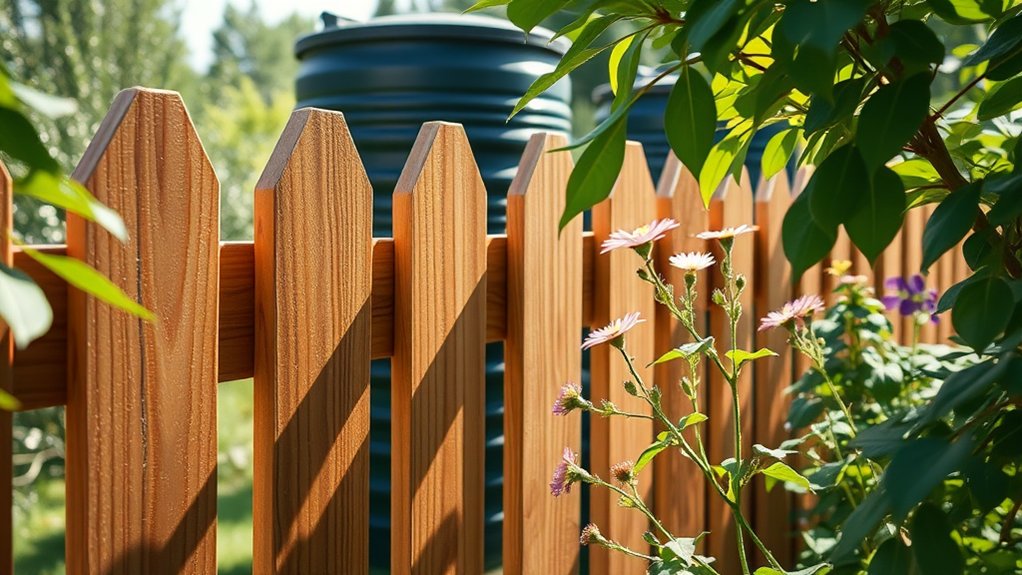
Selecting the right fencing is crucial for handling unpredictable weather. Here are some top options:
- Composite Fencing: This option resists rotting, warping, and pests, making it suitable for different climates.
- Rammed Earth Fences: These fences offer strong protection and naturally regulate temperature, keeping your space cooler in summer and warmer in winter.
- Recycled Plastic Fencing: Tough and weather-resistant, this type requires little maintenance and lasts a long time.
- Metal Fencing: Aluminum and steel fences can handle high winds and are easy to care for.
Each of these choices provides durability and sustainability, ensuring your fence stands the test of time.
Integrating Natural Elements Into Fencing
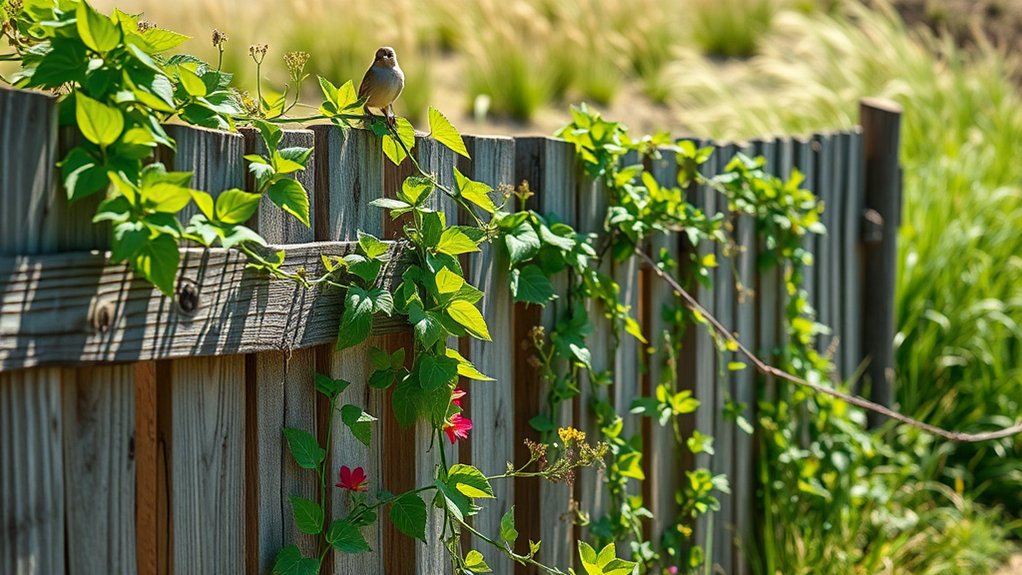
Integrating natural elements into your fencing can enhance its look and support sustainability. Use materials like reclaimed wood or local stone to help your fence blend into the landscape.
Consider bamboo for its rapid growth and carbon absorption, or use living plants for a more organic feel. Design your fence with curves and open patterns to allow wildlife movement and improve visual appeal.
Hand installation reduces soil disruption, and natural anchors protect roots. By focusing on these eco-friendly designs, your fence can serve practical purposes while maintaining harmony with nature.
Supporting Local Biodiversity With Fencing Choices
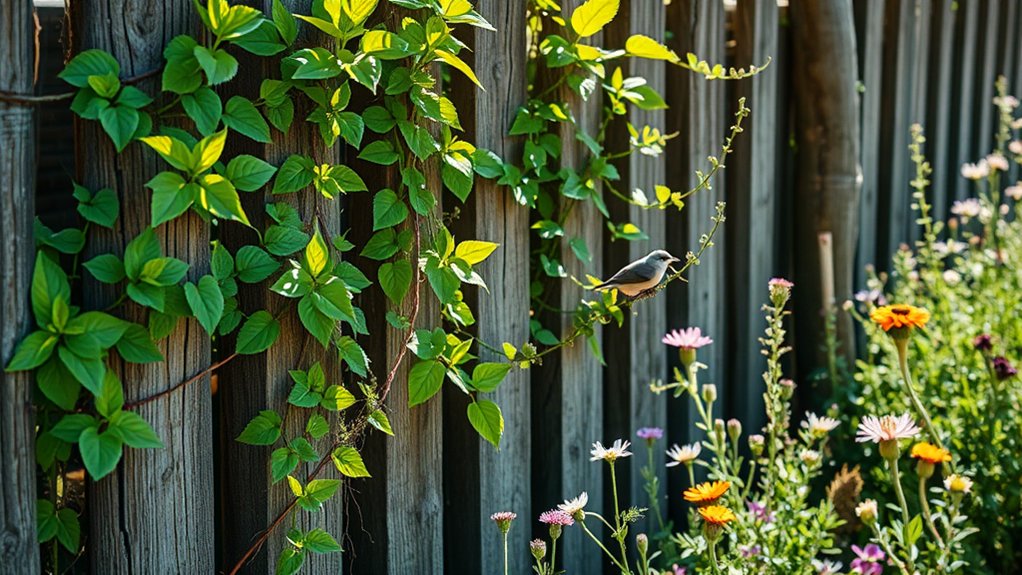
Fencing isn’t just about boundaries; it can significantly affect local biodiversity. By choosing sustainable materials, you can support wildlife and enhance ecosystems. Here are some options:
- Living fences made from native plants create pathways for wildlife.
- Bamboo fencing grows quickly and helps absorb carbon.
- Composite materials use less waste and resemble wood without harmful chemicals.
- Recycled metal can provide homes for various species.
These choices reduce resource use and promote local biodiversity.
Engaging the Community in Sustainable Practices
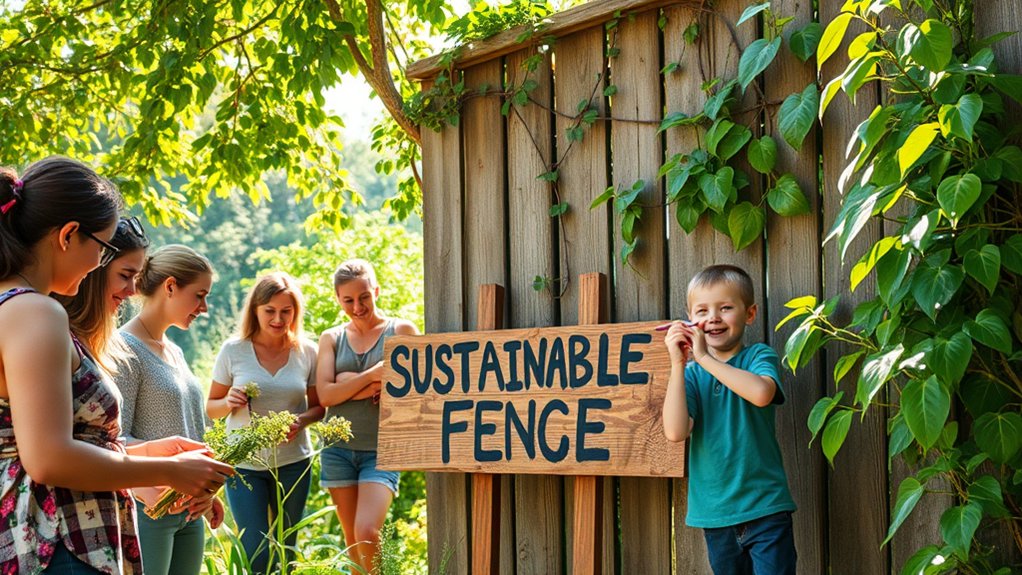
Engaging the community in sustainable practices is vital for building ownership and responsibility toward local environmental efforts.
Organizing workshops allows residents to share their ideas and insights, leading to better project outcomes that align with sustainability goals. When community members are involved, projects tend to finish on time and within budget, thanks to local knowledge and shared priorities.
To encourage participation, tackle barriers like lack of awareness and resources, and offer flexible ways for everyone to join in.
Keep communication open and celebrate small victories to build trust and commitment to sustainability in your community.
Long-Term Planning for Sustainable Fencing
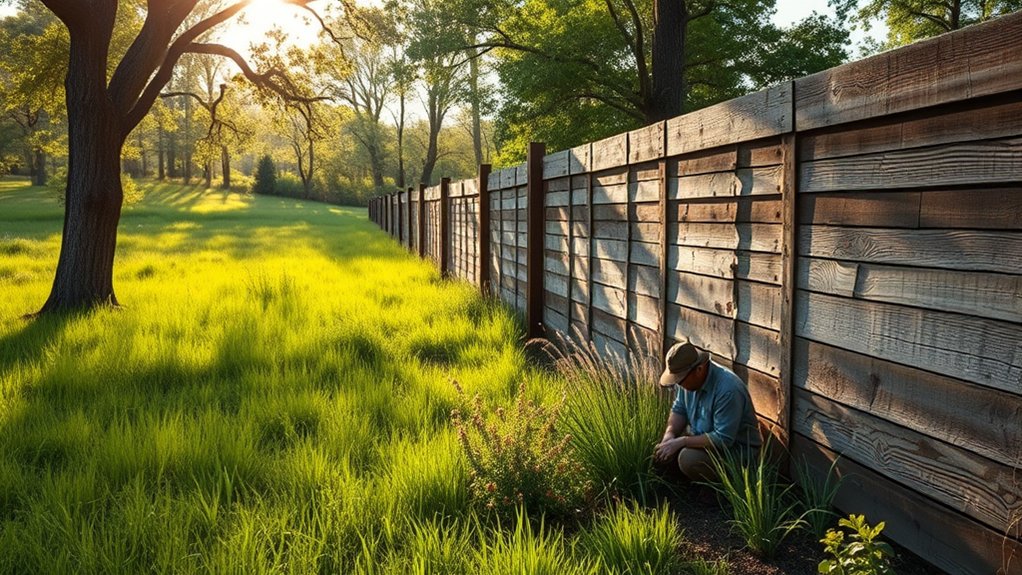
When planning sustainable fencing, focus on durability and adaptability to ensure your investment lasts. Here are some key strategies:
- Material Choice: Opt for materials like reclaimed wood or recycled composites for long-lasting fences.
- Maintenance Plans: Create maintenance schedules that align with natural cycles to minimize repairs.
- Periodic Upgrades: Schedule regular updates using eco-friendly materials to improve durability.
- Cost Analysis: Evaluate the long-term financial and environmental benefits of your material choices.
Frequently Asked Questions
How Can I Determine the Sustainability of Fencing Materials?
To assess the sustainability of fencing materials, look for sustainable resources, check for certifications like FSC, and evaluate production methods. For example, choosing bamboo or recycled materials often has a lower environmental impact. This approach ensures you’re making eco-friendly choices.
What Are the Benefits of Using Recycled Fencing Materials?
Using recycled fencing materials helps you cut costs and lower your environmental impact. These materials are often just as durable and weather-resistant as new ones, which means less maintenance and long-term savings. It’s a smart choice for both your wallet and the planet.
How Often Should I Inspect My Sustainable Fence?
Inspect your fence quarterly, do quick visual checks monthly, and perform thorough assessments after severe weather. This routine helps catch problems early, keeping your fence strong and functional. For example, after a storm, check for loose boards or damaged posts to avoid bigger issues later.
Can I Compost Old Wooden Fence Materials?
Old wooden fence materials can’t be composted because they’re too large and may contain chemicals. Instead, think about repurposing them for garden projects or look for local wood recycling programs. This way, you can manage the materials sustainably and reduce environmental impact.
What Should I Do if My Fence Requires Repairs?
If your fence needs repairs, stay calm—it’s manageable! Use eco-friendly tools and techniques, such as reclaimed wood and non-toxic finishes, to fix it while being kind to the planet.
Conclusion
To build a sustainable fence, choose eco-friendly materials and practices that blend with the environment. Consider your fence as a protector of nature, helping local wildlife thrive. Involve your community in these initiatives for a greater impact. With smart planning and low-maintenance options, your fence can be a lasting, environmentally-friendly addition that benefits you and the planet.


